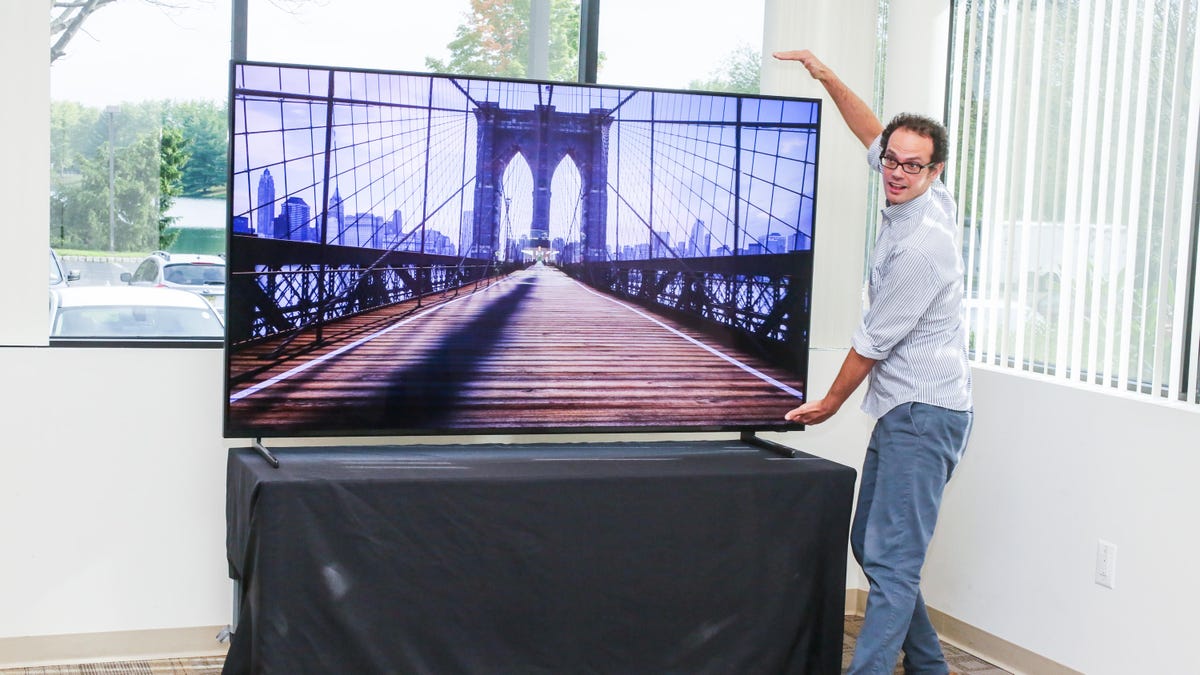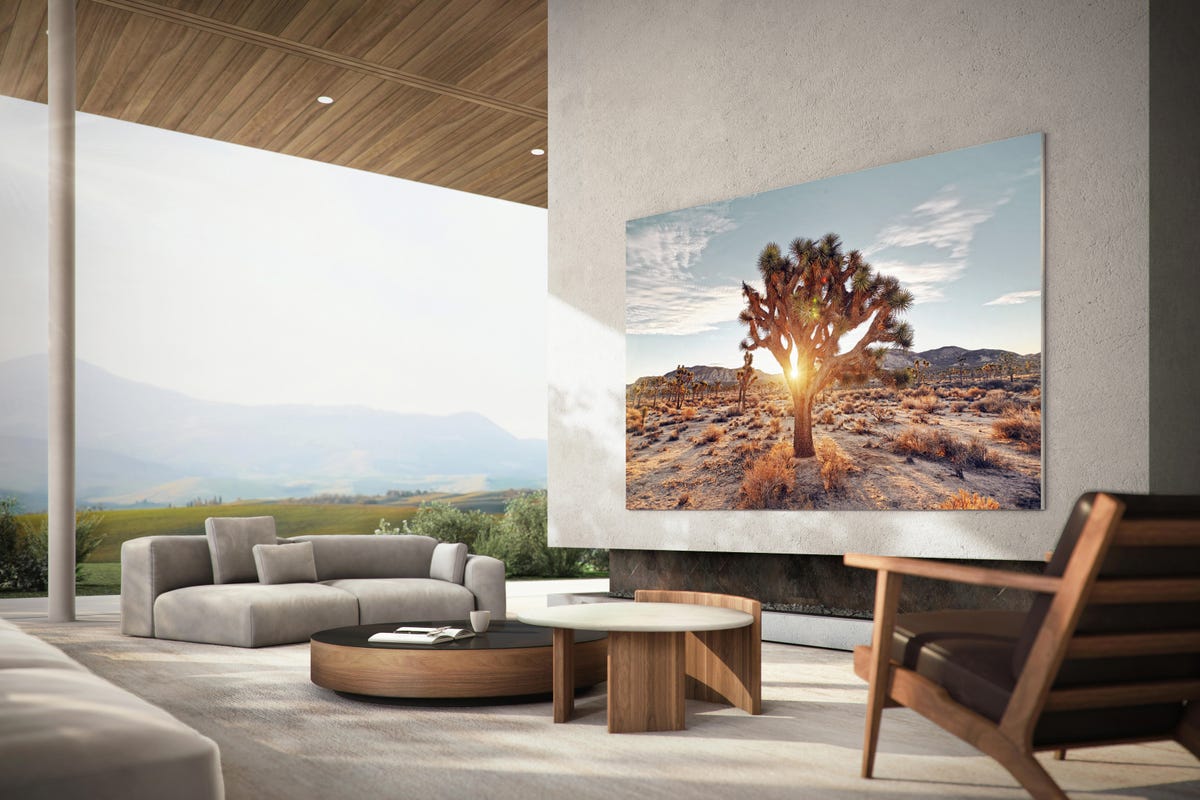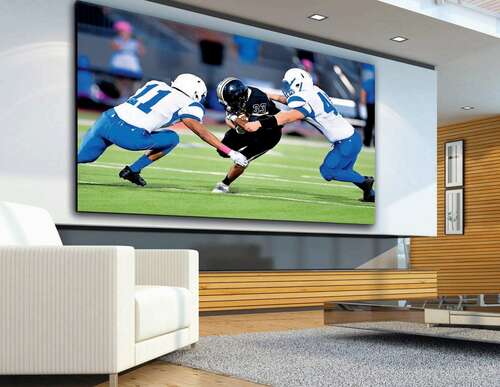If you’re considering replacing your TV, consider that you can probably get a much larger TV than you might think. If it’s been a while since you bought your current TV, you might be surprised to learn that what was once considered “large” is often considered “midsize” at most. Today, even 50-inch TVs aren’t widely considered to be “big.”
The increases in TV sizes over the last few years are because manufacturers can make larger screens more cheaply, along with 4K and 8K resolutions making huge TVs more usable. Ultraslim designs also mean that larger screens take up less space.
So if you’re scouring for deals online or in-store, keep an eye out for larger sizes than you might have originally planned. The reality is, you can probably go a lot bigger. How big? Maybe you don’t need a TV the size of a wall or a TV that is a wall, but in most homes, a 65- or 75-inch TV will fit just fine.

Overall our advice is simple: Get as big a TV as you can afford. The longer answer depends on your room, your seating distance and the acceptance factor of any cohabiting co-deciders.
Here’s how to figure out how big you can go.
Read more: Best 75-Inch TVs for 2024
TV sizes and seating distance
If you ask TV and theatrical industry groups, they’ll tell you to measure your seating distance to determine the ideal screen size. The farther away you sit, obviously, the smaller your TV appears. The ideal s is to have a screen that fills a certain amount of your field of view, though how much is “ideal” is up for debate.
THX recommends, for example, that you multiply your seating distance (in inches or centimeters) by 0.835. This gets you the recommended screen diagonal. If you’re like most people and you’re sitting about nine feet from your TV (108 inches), THX recommends a screen roughly 90 inches diagonal. So yeah, that big 65-inch TV you’re looking at is not “too big,” at least as far as THX is concerned.

Consider 55 inches the minimum screen size for most living rooms.
The Society of Motion Picture and Television Engineers recommends a viewing angle of 30 degrees, which is quite a bit less than THX. To match SMPTE’s recommendation, multiply your seating distance by 0.625. So given our nine-foot example, that means a TV around 68 inches (so a 65- or 70-inch model would work).
While these are good guidelines, don’t take them as steadfast rules. It’s far too easy to get caught up in a numbers game when the reality is far more complex. There are additional factors in play.
Read more: Best Home Theater Projector for 2024

This 85-inch Samsung is pretty big. But is it big enough?
TV resolution and screen size: 4K, 8K, 1080p
Nearly all new TVs are Ultra HD 4K resolution. A growing number are 8K. Only the smallest and least expensive models are still merely HD (1080p or 720p).
To see all the detail available in a 4K or 8K resolution image you either need to sit very close, or have a very large TV. In fact, if you’re sitting nine feet away, even “big” TVs are still too small for you to see all the resolutions for which they’re capable. Or to put it another way, the resolution of your next TV is going to be plenty unless you’re sitting very close, or are getting an exceptionally large TV (over 100 inches). So yeah, you don’t need an 8K TV. If you want to know how far away you need to sit before you can no longer see individual pixels, Sony offers the following chart.
Sony’s recommended seating distance
| TV size | Viewing distance range (approx.) |
|---|---|
| 43-inch | 35 inches (2.95 feet) |
| 49-inch | 39 inches (3.28 feet) |
| 55-inch | 39 inches (3.28 feet) |
| 65-inch | 47 inches (3.94 feet) |
| 75-inch | 55 inches (4.59 feet) |
| 85-inch | 63 inches (5.25 feet) |
The flip side is that with lower-quality content a big TV will expose more flaws. If you find yourself noticing blockiness, video noise or other artifacts when watching shows and movies on your current TV, a larger model will show those issues even more. Eagle-eyed viewers who want a bigger TV should also look for a better video to feed it, for example, 4K streaming and Blu-ray.
Read more: 8K TV Explained, and Why You Definitely Don’t Need One
TV room domination: How big is too big?
The other major factor to consider is something I’ll call “room domination.” How big does a TV have to be before that looming black rectangular slab seems to be the only thing in the room? This factor is definitely subjective. As someone who’s had a 12-foot-wide projection screen in his house for over a decade, and has also reviewed large TVs, I’ll take the big projection screen over a TV any day (not least because when the “TV” is off, a projector’s screen is white or gray, a TV is glossy black). An 80-plus inch TV can easily just dominate a space. Wall mounting can help a bit, but your TV room risks becoming the TV’s room.
Read more: 9 Tips to Prepare Your TV for Your Next Binge-Watch
If you have any doubts, try taping off or cutting out cardboard the size of the TV you’re thinking about, and seeing how it fares in your room. You might want to paint it or put some black cloth over it, too. That’s what it’s going to look like when it’s turned off (models like Samsung’s Frame TV notwithstanding). Maybe that’s not a concern for you, but it will be for some. Know that once the TV is actually in there, it will be way more awesome than cardboard, and probably brighter. It will also seem way, way bigger. It certainly depends on your room, décor and the opinions of others who share that room.

MicroLED promises even larger TVs, sizes once only possible with projectors.
Do bigger TVs make for a better viewing experience?
I’ll be honest, I don’t subscribe to any of the established “rules” for viewing distance and screen size. I think the SMPTE and the lesser THX numbers are too TV-biased. I think they vastly underestimate what’s easily possible with modern technology, for those who want more.
I sit nine feet from a 102-inch screen. That’s just the 16×9 portion. The full screen is 2.35:1 and 128 inches diagonal. I can just barely make out pixels when I expand a 1080p projector to the full width of the screen, but in standard 16×9 viewing, I can’t. 4K looks amazing. Watching TV this size is addictive, and I love it.
I mention this as proof you can go much larger than most people assume is possible. Check out how inexpensive, and bright, projectors have gotten. We’ve reviewed a bunch lately and have lists of the best projectors overall and the best 4K projectors.
Do you want to go that big? Well, that’s a different question. I find larger screen sizes easier on the eyes, as more of your field of view is taken up with the roughly uniform brightness of the screen. In an otherwise dark room, your pupils are more naturally closed to the amount of light thanks to the big screen.
Conversely, I find watching a small screen in a dark room more fatiguing, as your pupils are more open (because of the dark room) with this one annoying pinprick of bright light (the TV). Many people complain about headaches when they watch TV in a dark room. One possible cause is the hundreds of nits from an HDR TV taking up a tiny fraction of your field of view. Think about when someone shines a flashlight in your eyes when you’ve been in the dark for an hour. With a projector, you’ve got far less light than what a TV produces, and it’s spread out over a huge swath of your vision.
True bias lights, leaving the room lights on and turning down an LCD’s backlight can minimize fatigue as well or better than a big screen, but I like watching TV in a dark room. To each their own.

Bottom line: You could go much, much bigger with your next TV
The ultimate decision is one of personal preference. My goal here was to point out a rough idea of what’s possible or recommended. For me, I would always err on the side of “too big.” An old boss of mine used to say that no one regretted buying a TV they thought might be “too big.” My opinion is that a 50-inch TV is too small for most rooms. That’s not to say I think everyone should get a 102-inch screen, but the reality is a 50-inch flat panel is really not that much larger than the 36-inch CRTs of the old days. Since 65- and even 75-inch TVs are now far more affordable, they’re worth considering if you’ve got the space.
If you want to go really big, consider a projector instead if you’ve got control over the ambient light in your room.
Best TVs by size
As well as covering TV and other display tech, Geoff does photo tours of cool museums and locations around the world, including nuclear submarines, massive aircraft carriers, medieval castles, epic 10,000-mile road trips, and more. Check out Tech Treks for all his tours and adventures.
He wrote a bestselling sci-fi novel about city-size submarines and a sequel. You can follow his adventures on Instagram and his YouTube channel.

